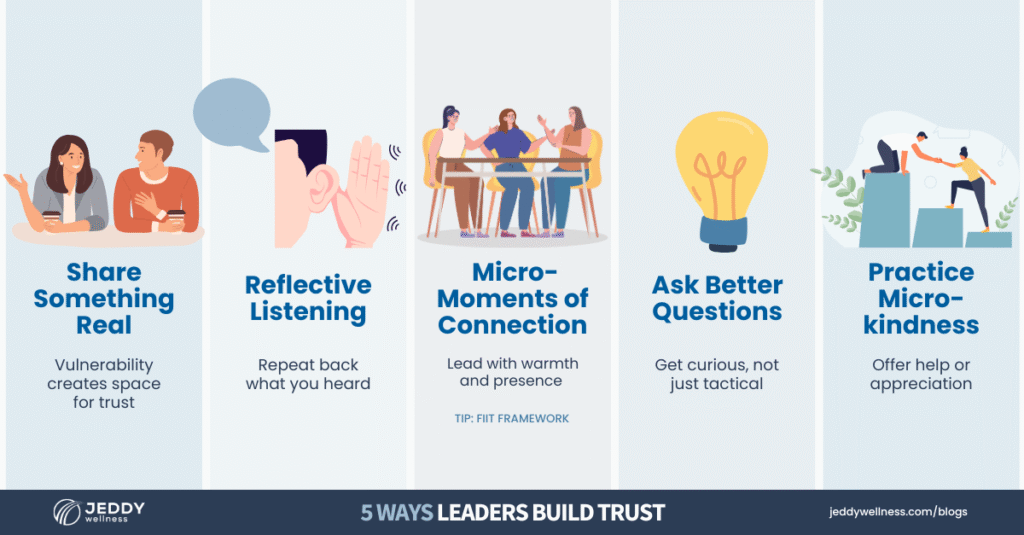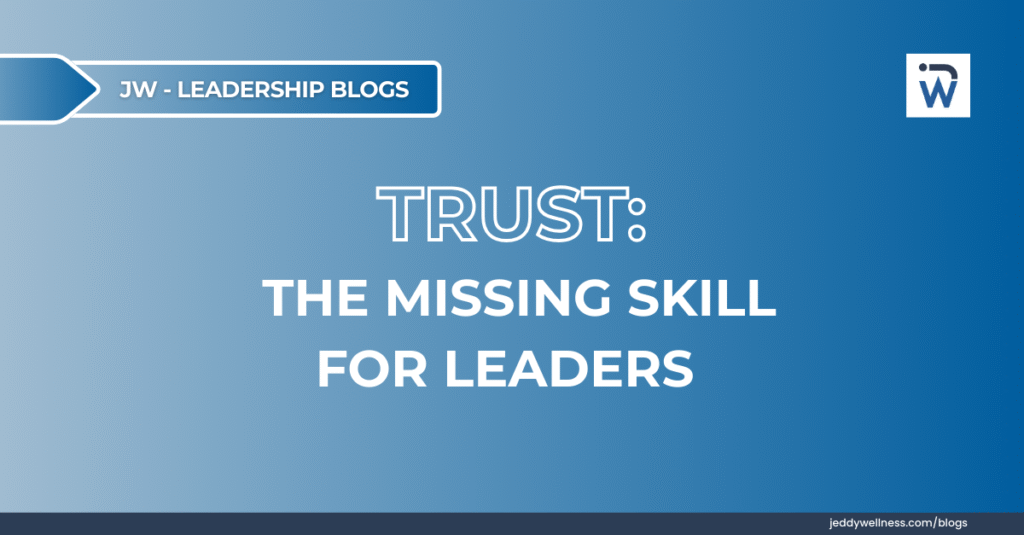Who Do You Trust?
Think of two people in your life you deeply trust.
Why do you trust them?
What have they done consistently to make you feel safe?
When I did this exercise, my mom came to mind. She’s open. She’s honest. We have deep, meaningful conversations, and I never doubt that she has my back. That kind of trust doesn’t come from achievements. It comes from presence, care, and consistency.
Now flip the question
Who are two people at work you believe trust you?
And what have you done to earn that trust?
Did you follow through when it mattered?
Were you honest, even when it was uncomfortable?
Did you create space for real conversations, not just check-ins about deadlines?
Trust isn’t declared. It’s demonstrated actively.
But in many workplaces, we prioritize speed, performance, and deliverables. The quiet, consistent behaviors that build connection often get lost in the noise.
That disconnect has consequences. Without trust, teams become misaligned, communication breaks down, and leaders burn out trying to manage it all.
To fix this, we need to understand what drives trust beneath the surface. It starts with how our brains are wired.
The Neurobiology of Trust
To understand why trust often feels like an afterthought at work, we need to go deeper than company values or culture decks. We need to understand how we’re wired.
Neuroscience tells us that two key chemicals shape how we show up with each other:
- Dopamine gives us a rush when we chase something, like hitting a goal or getting praise. It is short-term and motivating, but also addictive.
- Oxytocin is different. It creates calm, trust, and connection. It is released when we feel supported, safe, and truly seen.
The problem is that most workplaces are built around dopamine. We reward output and urgency. But without emotional safety, those systems slowly erode trust.
Google’s Project Aristotle revealed what actually drives high-performing teams. After studying more than 180 teams, the most important factor wasn’t intelligence or skill.
It was psychological safety.
Key message: When people feel safe enough to speak up, take risks, and admit mistakes, trust begins to grow. And when trust enters the equation, everything changes.

The Science of Sustainable Leadership
When people feel safe enough to speak up, take risks, and admit mistakes, trust begins to grow.
And when trust enters the equation, everything changes.
You’ve probably felt the opposite. Teams where people are not on the same page. Where you need to follow up, double-check, or micromanage. Where it feels like trust is always fragile.
That kind of leadership is exhausting. It burns you out.
Don’t you wish you could just trust your team so you could finally breathe?
Psychological safety is the entry point.
Trust is what builds from there.
More evidence
Case studies show that when safety and trust are present, teams experience:
- Team synchronization where people work in alignment and anticipate each other’s needs
- Collective flow a shared state of deep focus and effortless collaboration
- Innovation people feel safe enough to take risks and offer ideas
- Sustainable performance driven by shared respect and openness
How to Build Trust, Not Just Talk About It
Trust is not built through titles or policies. It is built through behavior.
Here are small actions you can take every day to lead with more presence and care:
👉 Share Something Real
Talk about a challenge you’ve faced or something you’re working on. Vulnerability creates space for trust.
👉 Reflective Listening
Instead of reacting, repeat back what you heard.
Example: “What I’m hearing is that you felt left out of the decision. Is that right?”
👉 Create Micro-Moments of Connection
Nonverbal cues like eye contact and a warm hello can reduce stress and increase openness. These small moments create psychological safety and connection.
In remote teams, this often disappears when cameras are off and interactions feel transactional.
To bring it back, turn your camera on when possible, use people’s names, and open meetings with a brief personal check-in. These gestures help reintroduce presence, even from a distance.
Tip 💡: You can make these moments more intentional using the FITT framework: Frequency, Intensity, Time, and Type.
👉 Ask Better Questions
Try questions like:
“What has been the most energizing part of your week?”
In remote settings, check-ins like these matter even more. Without hallway conversations or visible body language, it’s easy for people to feel unseen.
Use direct messages or team calls to open up space for real dialogue. A thoughtful question can build trust and connection across any distance.
Tip 💡: Relationship-building communication is a type of workplace communication. These conversations foster trust, connection, and a sense of belonging.
👉 Practice Micro-Kindness
Offer help, express appreciation, or check in. These gestures build trust over time.
Did you know meaningful recognition buffers against burnout?
Final Reflection
Trust is not a one-time event. It is a culture you create every day.
You do not need to change everything. Start with one action. Repeat it. Then build from there.
According to Gallup’s 2025 data, 79 percent of employees are disengaged. If we want engaged teams, we need to actively create and nurture trust.
Just like well-being, trust is not passive. It takes intention and consistency.
The most powerful kind of leadership is the kind people feel safe inside.
That is where people grow.
That is where teams thrive.
Start there.
For further insights on cultivating trust through self-awareness, you might find our blog on Self-Awareness in Leadership valuable.
Written By: Jason Roeder and Sumana Jeddy
______________________________
Stay Connected with Jeddy Wellness
Discover evidence-based research and innovative strategies to build and activate healthier workplaces.
💬 Want to Build a Recovery-Driven Culture?
👉 Book a Recovery Strategy Session with Jeddy Wellness.
Learn how to lead with more clarity, energy, and consistency without burning out your people or yourself.

Before You Add More: Subtract What Drains You
It’s 11:15 PM. Your laptop is still open. You’ve put in 10+ hours every day this week. Your brain feels foggy, your eyes are sore,


